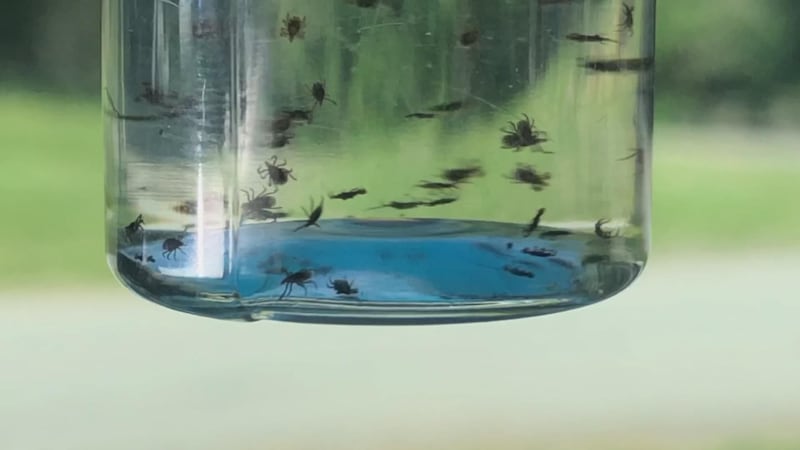ALLEGHENY COUNTY, Pa. — The weather has been gorgeous lately. Most of us are taking advantage of it and getting outside. Out on a walk in the woods with the Allegheny County Health Department, it didn’t take long to find ticks.
“We’re living in a city full of ticks,” said Kate O’Brien.
O’Brien likes taking her dog to Highland Park.
“We took a just a walk through the back woods, and when I got into the car, he was completely covered with them,” said O’Brien. “I pulled off like 45 of them.”
She says she checks for ticks all the time now. She had Lyme Disease and so did one of her dogs.
“Every time we find a tick, we send it off to the tick research lab because Lyme Disease is the worst,” said O’Brien.
Less than 100 yards away from the dog park in Highland Park, the Allegheny County Health Department surveyed for ticks. Nick Baldauf is a vector control specialist with the health department. He says he does tick drags weekly in parks such as Highland and Shenley. Historically, Baldauf says they’re seeing more ticks now than they have been seeing in the past.
“We do have a couple ticks,” said Baldauf. “They’re the nymphal black-legged ticks. They are about the size of a poppy seed. These are the ones typically responsible for Lyme disease. They’ll be out May, June, and July, but the size is what makes them dangerous.”
Every tick he collects is tested.
“They’ll test for Lyme, Anaplasma and Babesia,” said Baldauf. “Lyme and Anaplasma are both bacteria, and Babesia is a parasite. We found Babesia in Allegheny County for the first time in 2022.”
He says in Pennsylvania about 25% of them carry Lyme Disease. In Allegheny County, that number is closer to 30%. He stressed the importance of doing tick checks because it’s really hard to tell when a tick is on you.
“You’re not going to feel them crawl on your skin,” said Baldauf. “You’re not going to feel them bite.”
Baldauf also recommends spraying your shoes with a permethrin-based product, wearing light-colored clothing, checking for ticks, and taking a shower shortly after being in the woods.
“It takes a while for ticks to become attached,” said Baldauf. “A lot of ticks will crawl around your body for a little while looking for a cryptic place to become attached or they’ll look for thin skin. While they’re doing that, if you’re able to get back inside and get a shower, there’s a really good chance, you’re going to wash those off before they become attached.”
There are also some things you can do to your yard to deter ticks.
“I’ve been working on ‘de-tickafying’ my backyard,” said O’Brien.
O’Brien says she’s been planting vegetation over the last two years to try to keep out the ticks.
“I’ve been switching out the grass for wild thyme,” said O’Brien. “I’ve been planting lavender and cold hardy rosemary as landscaping plants. I’ve been doing that because the deer don’t like it and the mice don’t like it. It’s those animals that are bringing the ticks into your living space.”
O’Brien says hostas are like a deer salad bar. She says she likes to plant hellebores instead and mixes in the thyme with clover.
Here’s what Baldauf recommends.
“Ticks like moisture because they’re prone to drying out,” said Baldauf. “So you can take some precautions by manicuring your lawn to make it more tick unfriendly. If you keep your grass cut lower, the ticks don’t like that. If you move playground equipment and toys away from a wood line. That’s a good preventative measure. Another step you can take, if you establish a gravel or mulch barrier around the perimeter of your grass between the grass and the wood line to make it less likely that the ticks are going to venture into your yard.”
If you do find a tick attached to your skin or your pets, Baldauf says the best thing to do is to get fine-tip tweezers. Grab the tick as close as you can to its head and pull it directly up.
Baldauf says typically it’s between 24-36 hours of attachment that disease transmission can occur.
“There is another disease that we’re just starting to see called Powassan Virus, and it’s thought that transmission can occur in as little as 15 minutes,” said Baldauf.
Baldauf says Powassan Virus was first found in Allegheny County in 2021.
Click here for more information on what to do if you’re bitten by a tick.
Information on ticks and Lyme disease can be found here.
Download the FREE WPXI News app for breaking news alerts.
Follow Channel 11 News on Facebook and Twitter. | Watch WPXI NOW
TRENDING NOW:
©2023 Cox Media Group








